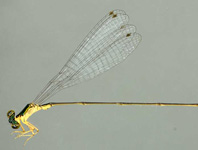Abstract
Both Pentalonia nigronervosa and P. caladii are distributed throughout the tropics and subtropics wherever suitable hosts are grown. To clarify the host relationships of both species on a global scale, the morphology of museum specimens of Pentalonia comprising 447 samples from 77 countries was examined, and all available mitochondrial COI sequences were analysed. Pentalonia nigronervosa is confirmed to feed almost exclusively on Musaceae (sensu stricto), while P. caladii feeds on other Zingiberales and on Araceae. Heliconia is accepted by both species. Molecular evidence suggests that there is an additional widespread species.
References
Basu, A.N. (1968) One new genus and seven new species of aphids from Darjeeling District, West Bengal (Homoptera: Aphididae). Bulletin of Entomology, 9, 143–157.
Bhadra, P. & Agarwala, B.K. (2010) A comparison of fitness characters of two host plant-based congeneric species of the banana aphid, Pentalonia nigronervosa and P. caladii. Journal of Insect Science, 10,140.
https://doi.org/10.1673/031.010.14001
Bhadra, P. & Agarwala, B.K. (2012) On the morphological and genotypic variations of two congeneric species of banana aphid Pentalonia (Homoptera: Aphididae) from India. Advances in Life Sciences, 2 (3), 75–81.
https://doi.org/10.5923/j.als.20120203.06
Bhanotar, R.K. & Ghosh, L.K. (1969) On oviparous morph of Pentalonia nigronervosa Coquerel (Aphididae: Homoptera) from West Bengal, India. Bulletin of Entomology, 10, 97–99.
Eastop, V.F. (1967) A new species of Pentalonia Coquerel (Hem., Aphididae). Entomologist’s Monthly Magazine, 102, 145–146.
Foottit, R.G., Maw, H.E.L., Pike, K.S. & Miller, R.H. (2010) The identity of Pentalonia nigronervosa Coquerel and P. caladii van der Goot (Hemiptera: Aphididae) based on molecular and morphometric analysis. Zootaxa, 2358 (1), 25–38.
https://doi.org/10.11646/zootaxa.2358.1.2
Lee, W., Kim, H., Lim, J., Choi, H.-R., Kim, Y., Kim, Y.-S., Ji, J.-Y., Foottit, R.G. & Lee, S. (2011) Barcoding aphids (Hemiptera: Aphididae) of the Korean Peninsula: updating the global data set. Molecular Ecology Resources, 11, 32–37.
https://doi.org/10.1111/j.1755-0998.2010.02877.x
Martin, J.H. (1987) Notes on the apterae viviparae of Pentalonia gavarri Eastop (Homoptera, Aphididae). Tropical Pest Management, 33 (4), 37–376.
https://doi.org/10.1080/09670878709371189
Padmalatha, C. & Ranjit Singh, A.J.A. (2001) Morphometric variations in Pentalonia nigronervosa Coq. (Homoptera: Aphididae) in relation to host plants. Uttar Pradesh Journal of Zoology, 21, 173–176.
Rebijith, K.B., Asokan, R., Krishna Kumar, N.K., Krishna, V., Chaitanya, B.N. & Ramamurthy, V.V. (2013) DNA barcoding and elucidation of cryptic aphid species (Hemiptera: Aphididae) in India. Bulletin of Entomological Research, 103, 601–610.
https://doi.org/10.1017/S0007485313000278
Robbertse, N., Omondi, B.A., Miller, I.M., Kruger, K. & Jooste, A.E.C. (2019) Non-destructive DNA extraction from aphids: the application in virus-vector studies of Banana bunchy top (BBTV). European Journal of Plant Pathology, 153, 571–582.
https://doi.org/10.1007/s10658-018-1552-2
Savory, F.R. & Ramakrishnan, U. (2015) Cryptic diversity and habitat partitioning in an economically important aphid species complex. Infection, Genetics and Evolution, 30, 230–237.
https://doi.org/10.1016/j.meegid.2014.12.020
Watanabe, S., Greenwell, A.M. & Bressan, A. (2013) Localization, concentration, and transmission efficiency of Banana bunchy top virus in four asexual lineages of Pentalonia aphids. Viruses, 5, 758–775.
https://doi.org/10.3390/v5020758

